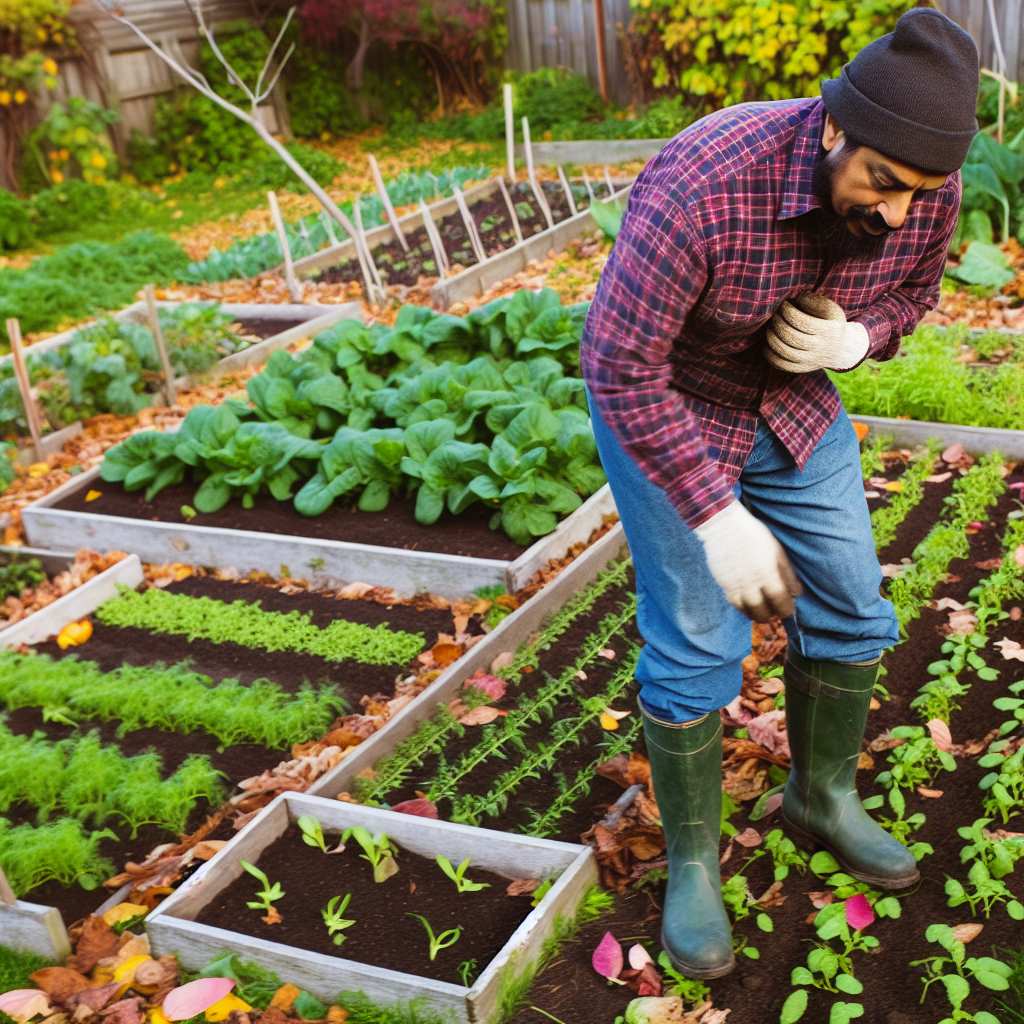Understanding Seasonal Changes
How Climate Affects Small-Scale Farming
Seasonal changes play a critical role in small-scale farming in the USA.
Climate impacts crop selection.
It also affects planting times and harvesting schedules.
Farmers must understand these changes to make informed decisions.
Key Climatic Factors
Temperature variations directly influence plant growth and development.
Rainfall patterns determine irrigation needs and soil moisture levels.
Wind and humidity can also affect crop health and yields.
Regional Climate Differences
The USA experiences diverse climates across its regions.
Western states often deal with arid conditions.
The East has ample rainfall.
Understanding these regional differences helps farmers select suitable crops.
Seasonal Planting Strategies
Farmers can maximize productivity by aligning planting with seasonal changes.
Early spring is ideal for cool-weather crops like lettuce and peas.
Summer is perfect for warm-season crops such as tomatoes and peppers.
Adaptation to Climate Variability
Climate variability poses challenges for small-scale farmers.
Transform Your Agribusiness
Unlock your farm's potential with expert advice tailored to your needs. Get actionable steps that drive real results.
Get StartedFarmers can adapt by exploring heat-resistant crop varieties.
Additionally, practicing crop rotation can enhance soil health.
Soil conservation techniques are crucial for maintaining productivity.
Utilizing Technology
Modern technology aids farmers in monitoring weather patterns.
Farm management software can provide insights for better planning.
Weather apps help farmers stay informed about impending changes.
Soil Preparation for Various Seasons
Importance of Soil Quality
Healthy soil is essential for strong plant growth.
It provides nutrients.
It retains moisture.
It fosters beneficial microorganisms.
Moreover, good soil structure enhances root development.
Spring Soil Preparation Techniques
Begin your spring soil preparation by testing pH levels.
Adjust acidity or alkalinity based on the test results.
Add organic matter, such as compost or well-rotted manure.
This improves soil fertility and structure effectively.
Next, till the soil gently to aerate it.
Consider planting cover crops during winter to enrich soil nutrients.
Summer Soil Maintenance
During the summer, monitor soil moisture levels regularly.
Mulch around plants to retain moisture and suppress weeds.
Additionally, avoid over-tilling, as this can lead to soil compaction.
Incorporate organic fertilizers to support plant growth during peak season.
Fall Soil Preparation
In the fall, remove any remaining plant debris from the garden.
Conduct soil tests again to prepare for winter conditions.
Add cover crops to improve soil health over the winter months.
Showcase Your Farming Business
Publish your professional farming services profile on our blog for a one-time fee of $200 and reach a dedicated audience of farmers and agribusiness owners.
Publish Your ProfileThis practice will help prevent erosion and promote nutrient cycling.
Winter Soil Care
Winter is a time for rest, but soil care remains important.
Avoid compacting the soil by staying off wet areas.
Consider using winter covers, such as tarps, to protect soil from erosion.
This shields the soil from heavy rains and freezing temperatures.
Selecting the Right Crops
Understanding U.S. Growing Zones
The United States categorizes its climate into growing zones.
These zones help farmers choose appropriate crops.
Each zone has specific temperature and weather patterns.
Familiarity with these zones enhances crop success.
Spring Planting Guide
Spring is an excellent time for starting many crops.
Cool-season crops thrive in early spring.
Examples include lettuce, peas, and spinach.
Warm-season crops are ideal for late spring planting.
Corn, tomatoes, and squash are popular warm-season options.
Summer Planting Tips
Summer is ideal for growing heat-loving crops.
Consider planting beans, eggplants, and peppers.
These crops prefer warm temperatures and full sun.
Additionally, ensure consistent watering during hot months.
Fall Crop Selection
Fall allows for planting of crops that withstand cooler temperatures.
Brassicas, such as broccoli and kale, do well in fall.
Other options include root vegetables like carrots and turnips.
Consider using row covers to extend the growing season.
Winter Gardening Options
Winter gardening may seem challenging but is achievable.
Cold frames and greenhouses can protect sensitive crops.
Consider hardy varieties like spinach and garlic.
These can be sown in late fall for winter harvests.
Crop Rotation and Soil Health
Effective crop rotation maintains soil health over time.
This practice helps prevent soil depletion and pest buildup.
Rotate crops based on their nutrient needs and growth patterns.
Legumes, for example, enrich the soil with nitrogen.
Adapting to Local Conditions
Every small-scale farm faces unique challenges.
Evaluate local conditions such as soil type and rainfall.
Adjust your crop selections based on these factors.
Consult local agricultural extension services for guidance.
Gain More Insights: Small Livestock Management for Climate-Resilient Farming Practices
Water Management Strategies
Irrigation Techniques for Seasonal Variability
Water management is crucial for successful small-scale farming.
Farmers must adapt their irrigation techniques based on seasonal changes.
Effective irrigation strategies enhance water efficiency and crop yield.
Understanding Seasonal Impact
Seasons significantly affect plant growth and water requirements.
In summer, crops often require more frequent watering.
Showcase Your Farming Business
Publish your professional farming services profile on our blog for a one-time fee of $200 and reach a dedicated audience of farmers and agribusiness owners.
Publish Your ProfileConversely, winter may necessitate reduced irrigation levels.
Drip Irrigation Systems
Drip irrigation delivers water directly to the plant roots.
This method minimizes evaporation and runoff.
As a result, it increases water efficiency and reduces waste.
Farmers can control water application more precisely with this system.
Rainwater Harvesting
Collecting rainwater offers a sustainable water source.
This practice reduces dependency on municipal supplies.
Farmers can use storage systems to capture runoff during rainy seasons.
The stored water can then be utilized during dry periods.
Soil Moisture Monitoring
Monitoring soil moisture helps farmers determine irrigation needs.
Farmers can implement sensors to track moisture levels accurately.
Such technology allows for timely watering, preventing under or over-irrigation.
Water-Conserving Practices
Implementing mulch can significantly reduce water loss.
Mulch retains soil moisture and offers additional benefits for plants.
Moreover, crop rotation can improve soil structure and moisture retention.
Farmers should consider cover crops to enhance soil health as well.
Choosing the Right Timing
Irrigating during early mornings or late evenings minimizes evaporation.
Farmers should avoid watering during peak sunlight hours.
Timely irrigation maximizes water absorption and minimizes waste.
Uncover the Details: Sustainable Crop Rotation Strategies for Small Farmers
Crop Rotation and Diversity: Best Practices for Sustainable Yields
The Importance of Crop Rotation
Crop rotation fosters soil health and reduces pest buildup.
It minimizes the risk of crop disease and nutrient depletion.
Farmers can optimize yields by changing crops each season.
Incorporating legumes can naturally enrich soil nitrogen.
This practice prevents over-reliance on chemical fertilizers.
Diversifying Crop Selection
Diversity in crops enhances ecosystem resilience.
Growing various plants protects against climate variability.
It also appeals to a wider market by offering varied produce.
Farmers can experiment with heirloom varieties for unique flavors.
Using companion planting can improve crop health and yield.
Implementing Effective Crop Rotation Plans
Start by identifying your soil type and its nutrient needs.
Plan rotations based on crops’ nutrient requirements and growth cycles.
For example, follow heavy feeders with light feeders.
Document the history of crop planting to analyze trends.
Make adjustments based on the previous season’s performance.
Benefits of Crop Diversity
Diverse crops lead to a balanced ecosystem and soil health.
This balance attracts beneficial insects and soil microbes.
Moreover, it helps reduce the spread of pests and diseases.
Farmers benefit from increased resilience to extreme weather events.
Finally, diverse products can enhance community outreach and sales.
Showcase Your Farming Business
Publish your professional farming services profile on our blog for a one-time fee of $200 and reach a dedicated audience of farmers and agribusiness owners.
Publish Your ProfileAddressing Challenges in Crop Rotation and Diversity
Farmers may face challenges like market demand and logistical issues.
Adapting to local demand can help minimize wastage.
Additionally, investing in infrastructure can ease crop storage and transport.
Collaboration with local farmers can enhance knowledge-sharing.
Utilizing technology for tracking plant health can further improve yields.
Gain More Insights: How To Incorporate Drip Irrigation For Water Conservation In Community Gardens
Pest and Disease Management
Identifying Seasonal Challenges
Farmers face various pest and disease challenges throughout the seasons.
Spring often brings an influx of pests seeking fresh growth.
Common threats include aphids, caterpillars, and beetles.
Summer hosts diseases like blight and powdery mildew.
In fall, crop residue can harbor pests for the next planting season.
Each season requires vigilance and different strategies.
Organic Solutions for Pest Management
Organic solutions provide an effective means of managing pests.
Encourage beneficial insects such as ladybugs and lacewings.
These predators help control aphid populations naturally.
Planting herbs like basil can repel harmful insects.
Moreover, companion planting promotes healthy crop relationships.
Another effective organic method is crop rotation.
This practice disrupts pest life cycles, reducing their numbers.
Utilizing Natural Disease Control Methods
Preventing diseases requires proactive management strategies.
Start by maintaining healthy soil using compost and mulch.
Healthy soil supports robust plant growth, making them more resilient.
Employing resistant plant varieties can be a game-changer.
Certain crops can withstand specific diseases better than others.
Furthermore, practicing proper spacing allows for air circulation.
Implementing Integrated Pest Management
Integrated Pest Management (IPM) combines various strategies.
This holistic approach uses biological, cultural, and chemical controls.
Farmers should regularly monitor pest populations and thresholds.
Once populations reach a certain level, take action.
Experience helps determine the most suitable intervention methods.
By doing so, farmers protect their crops while minimizing chemical use.
Seasonal Monitoring and Adaptation
Continuous monitoring is essential for effective pest management.
Observations help identify trends in pest populations over time.
Adapting strategies based on these observations increases success.
Farmers should document their findings for future reference.
This data informs better decision-making in subsequent seasons.
Moreover, attending local workshops can provide new insights.
Community Resources for Support
Local agricultural extensions offer valuable resources and support.
They provide information on pests and local disease outbreaks.
Collaboration with fellow farmers promotes sharing of successful strategies.
Showcase Your Farming Business
Publish your professional farming services profile on our blog for a one-time fee of $200 and reach a dedicated audience of farmers and agribusiness owners.
Publish Your ProfileEngaging in community forums can spark innovative solutions.
Always stay informed about the latest organic practices and products.
Utilizing these resources enhances overall pest management efforts.
Learn More: Best Organic Soil Management Practices For High-Yield Community Garden Plots

Maximizing Harvests
Understanding Seasonal Timing
Seasonal timing plays a crucial role in small-scale farming.
It determines when and what crops to plant for optimal yield.
Farmers must consider local climate conditions carefully.
Additionally, understanding frost dates is essential.
These dates affect the timing of planting and harvesting.
Creating Effective Planting Schedules
A well-structured planting schedule maximizes productivity.
Incorporating crop rotation can enhance soil health.
Farmers can create a diverse planting plan to use space effectively.
Choosing the right crops for each season is vital.
Some crops thrive in cooler weather, while others prefer heat.
Utilizing Frost Dates for Planning
Frost dates indicate the start and end of the growing season.
Farmers should consult local agricultural extensions for accurate dates.
Such information helps in selecting suitable planting times.
It can also assist in safeguarding crops against unexpected frost.
Understanding Your Growing Region
Each region has unique growing conditions and soil types.
Knowing the USDA Plant Hardiness Zone can guide crop choices.
Diverse environments require tailored farming strategies.
Researching regional best practices helps in adapting effectively.
Networking with local farmers can provide valuable insights.
Implementing Succession Planting
Succession planting involves staggering crop planting times.
This method extends the harvest window throughout the season.
It allows for continuous produce supply over time.
Farmers can adjust plans based on market demands and conditions.
Monitoring Environmental Changes
Climate changes constantly influence planting schedules and harvests.
Farmers should stay informed about local weather patterns.
Using technology can aid in predicting environmental changes.
Adjusting practices based on trends can improve sustainability.
Utilizing Cover Crops
Benefits for Soil Health
Cover crops play a crucial role in enhancing soil health.
They reduce soil erosion caused by wind and water.
Additionally, cover crops improve soil structure over time.
This leads to better water retention and aeration.
Moreover, they add organic matter back into the soil.
As a result, microbial activity increases significantly.
Healthy soil supports robust plant growth.
Enhancing Sustainability
Cover crops contribute to sustainable farming practices.
They reduce the need for synthetic fertilizers.
Showcase Your Farming Business
Publish your professional farming services profile on our blog for a one-time fee of $200 and reach a dedicated audience of farmers and agribusiness owners.
Publish Your ProfileThis minimizes chemical runoff into local waterways.
Furthermore, cover crops help suppress weed growth naturally.
This decreases the reliance on herbicides.
Ultimately, they foster a more balanced ecosystem on the farm.
Seasonal Considerations
Choosing appropriate cover crops requires seasonal awareness.
For example, winter rye flourishes in colder months.
Conversely, buckwheat thrives during warmer months.
Farmers should align crop selection with their regional climate.
This ensures maximum growth potential and benefits.
Incorporating Cover Crops into Your Farm
Integrating cover crops into your farming routine is essential.
Begin by selecting suitable varieties for your soil type.
Then, plant them during off-seasons or crop rotations.
Monitor their growth and manage them before planting main crops.
Finally, terminate cover crops appropriately before planting.
Winter Gardening Techniques: Preparing for Off-Season Production
Utilizing Cold Frames
Cold frames are excellent for winter gardening.
They provide protection from frost and harsh winds.
By using cold frames, you can extend your growing season.
This allows you to start seedlings earlier in the spring.
Choosing Hardy Crops
Selecting the right crops is crucial for winter gardening.
Opt for hearty vegetables like kale and spinach.
These crops thrive even in colder temperatures.
Furthermore, consider planting root vegetables such as carrots and beets.
Implementing Row Covers
Row covers can significantly improve winter crop yields.
They offer additional protection against frost damage.
Moreover, row covers promote warmth and humidity for delicate plants.
This translates to faster growth rates during winter months.
Companion Planting Strategies
Companion planting benefits winter gardens greatly.
Mixing crops can enhance growth and deter pests.
For example, planting garlic with greens can repel unwanted insects.
Likewise, intercropping can conserve space and resources.
Soil Preparation and Maintenance
Preparing your soil is essential before winter planting.
Adding organic matter boosts both fertility and structure.
Regular mulching can prevent erosion and retain moisture.
Additionally, ensure proper drainage to protect roots from rot.
Winter Indoor Gardening
Indoor gardening keeps you connected to your plants year-round.
Use grow lights to supplement natural sunlight during short days.
Herbs like basil and thyme thrive indoors and can be grown.
This approach provides fresh produce even in the winter.
Planning for Spring
Winter is an ideal time to plan for spring gardening.
Evaluate what worked well last year and what did not.
Showcase Your Farming Business
Publish your professional farming services profile on our blog for a one-time fee of $200 and reach a dedicated audience of farmers and agribusiness owners.
Publish Your ProfileMake a list of new crops or techniques to try.
Additionally, consider crop rotation to improve soil health.
Community-Supported Agriculture (CSA): Engaging Local Consumers with Seasonal Produce
Overview of CSA
Community-Supported Agriculture changes the relationship between consumers and farmers.
Members purchase a “share” of the farm’s harvest in advance.
This model provides financial support to farmers at the start of the growing season.
In return, members receive fresh, seasonal produce throughout the season.
Benefits for Farmers
CSA offers farmers reliable income during unpredictable weather patterns.
It also increases community engagement and fosters local relationships.
Additionally, farmers can diversify their crops based on consumer preferences.
Benefits for Consumers
Consumers enjoy direct access to fresh, organic produce.
They can often visit farms and connect with the growers.
This model promotes awareness of sustainable farming practices.
How to Start a CSA
Starting a CSA requires careful planning and market research.
First, identify your target market within your community.
Next, create a variety of seasonal produce that appeals to potential members.
Then, establish a pricing structure that reflects your costs and benefits.
Finally, implement a strong marketing strategy to attract members.
Challenges and Considerations
CSAs require commitment from both farmers and consumers.
Farmers must manage crop production effectively to meet member demands.
Moreover, consumers must commit to regularly picking up their shares.
Weather variability and pest issues can impact the harvest, presenting challenges.
Successful CSA Examples
Many successful CSAs demonstrate effective community engagement.
For instance, Ridgewood Heritage Farm combines education with their CSA program.
Another example is Evergreen Organic Farm, focusing on local distribution.
These models inspire new farms to adopt similar practices.
Additional Resources
Center for Urban Agriculture & Gardening Education | College of …
Are backyard food gardens better or worse for the environment than …




